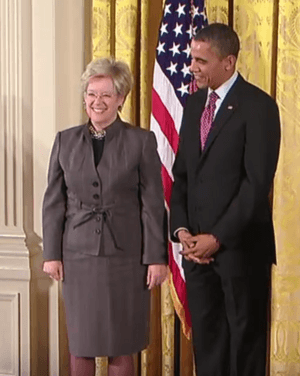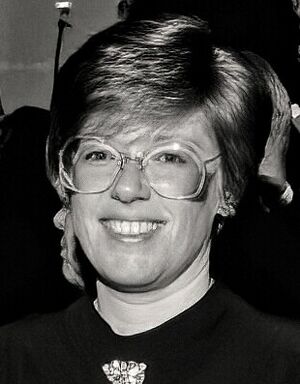Sandra Faber facts for kids
Quick facts for kids
Sandra M. Faber
|
|
|---|---|

Sandra Faber accepting the National Medal of Science from President Barack Obama in 2013
|
|
| Born |
Sandra Moore
December 28, 1944 |
| Nationality | American |
| Alma mater | Swarthmore College Harvard University |
| Known for | Faber–Jackson relation, Designing the Keck Observatory |
| Awards | Dannie Heineman Prize for Astrophysics (1985) National Medal of Science (2011) Bruce Medal (2012) Gruber Prize in Cosmology (2017) Magellanic Premium (2018) Gold Medal of the Royal Astronomical Society (2020) |
| Scientific career | |
| Fields | Astronomy |
| Institutions | University of California, Santa Cruz Lick Observatory |
| Thesis | Photometry of elliptical galaxies in multiple systems (1971) |
| Doctoral advisor | I. John Danziger |
| Doctoral students |
|
Sandra Moore Faber is a famous American astrophysicist. She was born on December 28, 1944. Dr. Faber is known for her important work on how galaxies change and grow over time. She is a professor of Astronomy and Astrophysics at the University of California, Santa Cruz. She also works at the Lick Observatory.
Dr. Faber helped discover a rule that connects how bright galaxies are to how fast stars move inside them. This rule is called the Faber–Jackson relation. She also played a big part in designing the powerful Keck telescopes in Hawaii.
Contents
Her Early Life and Education
Sandra Faber loved science from a young age. She went to Swarthmore College and studied physics. She also took classes in mathematics and astronomy. She earned her first degree in 1966.
Later, she went to Harvard University for her advanced degree. She earned her PhD in 1972. Her studies focused on observing the universe with optical telescopes. She married Andrew Leigh Faber in 1967. They have two daughters, Robin and Holly.
Amazing Discoveries and Contributions
In 1972, Dr. Faber joined the Lick Observatory at University of California, Santa Cruz. She was the first woman to be on the staff there. This was a big step for women in science.
Understanding Galaxies: The Faber–Jackson Relation
In 1976, Dr. Faber made a key observation. She noticed a link between how bright galaxies are and how fast their stars move. She worked with a student named Robert Jackson. Together, they created a scientific rule. This rule is now known as the Faber–Jackson relation. It helps scientists understand how galaxies work.
The Mystery of Dark Matter
Dr. Faber also did important work on dark matter. Dark matter is a mysterious substance in space. Scientists believe it makes up a large part of the universe. In 1979, she published a paper with John S. Gallagher. This paper brought together all the evidence for dark matter known at that time.
In 1983, she showed that dark matter was not made of fast-moving particles called neutrinos. Instead, she suggested it was made of slow-moving particles. Scientists still don't know what these particles are. They call this idea "cold dark matter."
How Galaxies Formed
Around 1984, Dr. Faber worked with other scientists. They included Joel Primack, George R. Blumenthal, and Martin Rees. They developed a theory about how dark matter helps galaxies form and grow. This was the first time anyone explained how galaxies developed from the Big Bang until today. Their ideas are still a main part of how scientists understand the universe's structure.
Building Powerful Telescopes
Dr. Faber was very involved in building the Keck Telescope. This telescope is in Hawaii. It is one of the largest optical telescopes in the world. It has a huge mirror that is 10 meters wide. She helped convince people around the world that these large telescopes were important.
She also worked on the Hubble Space Telescope. In 1985, she helped build the first wide-field camera for Hubble. In 1990, she helped get the camera ready to work in space. When Hubble's optics had a problem, Dr. Faber and her team helped figure out what was wrong. This was a very exciting time in her career.
Exploring Black Holes and Distant Galaxies
Dr. Faber led a group called the Nuker Team. They used the Hubble Space Telescope to look for supermassive black holes. These giant black holes are found at the centers of galaxies.
She also helped add a new tool to the Keck II telescope in 1996. This tool made the telescope much more powerful. It helped scientists see galaxies that are very far away. She also joined the CANDELS project. This project created the largest survey of the universe ever taken by the Hubble Telescope.
Today, Dr. Faber continues her research at UCSC. She studies how the universe's structure changes. She also looks at how galaxies form and evolve. She helped develop another tool for the Keck telescopes called DEIMOS. This tool helps get detailed information from distant galaxies. From 2012 to 2021, she was a co-editor for the Annual Review of Astronomy and Astrophysics.
Honors and Awards
Dr. Sandra Faber has received many awards for her amazing work. Some of her most notable honors include:
- 1985, Dannie Heineman Prize for Astrophysics
- 1985, Elected to the National Academy of Sciences
- 2011, National Medal of Science (This is a very high award in the U.S.)
- 2012, Bruce Medal
- 2012, Karl Schwarzschild Medal
- 2017, Gruber Prize in Cosmology
- 2018, Magellanic Premium Medal
- 2020, Gold Medal of the Royal Astronomical Society
A small planet, #283277 Faber, was named after her. This shows how important her contributions to astronomy are.
See also
 In Spanish: Sandra Faber para niños
In Spanish: Sandra Faber para niños
- Faber–Jackson relation
- Hubble Space Telescope
- Nuker Team


